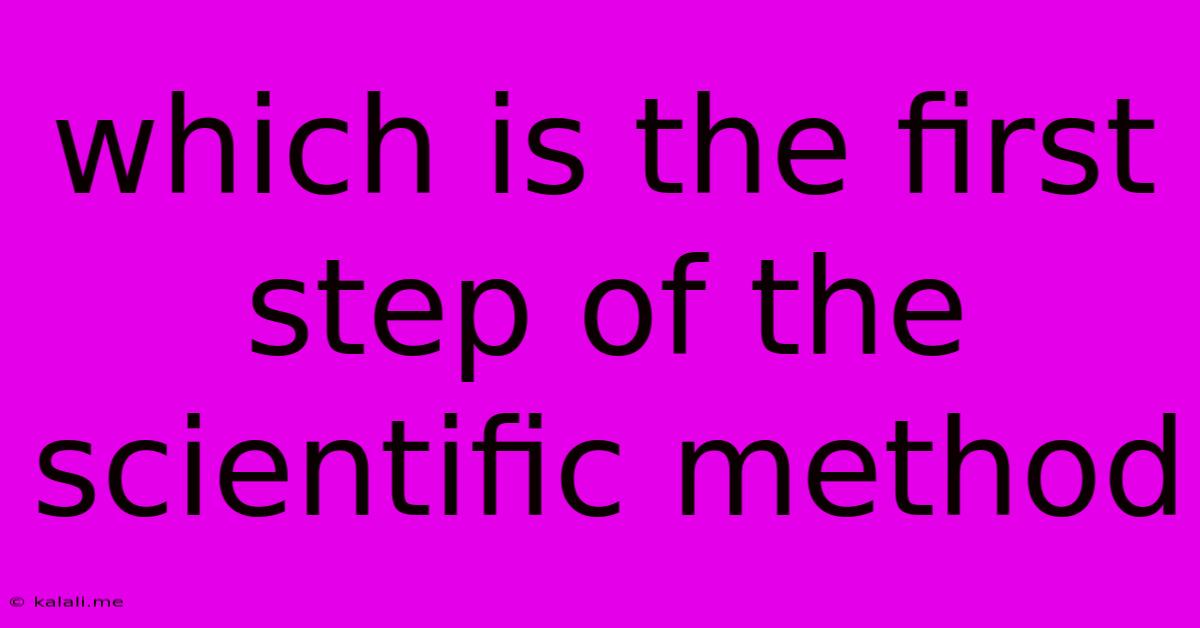Which Is The First Step Of The Scientific Method
Kalali
Jun 14, 2025 · 3 min read

Table of Contents
Which is the First Step of the Scientific Method? Making Observations: The Foundation of Scientific Inquiry
The scientific method is a cornerstone of scientific advancement, a systematic approach to understanding the world around us. While often presented as a linear process, it's more accurately described as a cyclical and iterative process, adapting and refining as new information emerges. But even with its iterative nature, there's a clear starting point: making observations. This article will delve into the crucial role of observation as the first step in the scientific method, exploring its importance and how it lays the groundwork for further investigation.
Understanding the importance of observation is key to unlocking the power of the scientific method. It's more than just passively looking; it's about actively engaging with the world, noticing patterns, and identifying questions that need answering. Think of it as the spark that ignites the entire process. Without a keen observation, there's no impetus for further exploration.
What Constitutes a Scientific Observation?
A scientific observation isn't just about seeing something; it's about recording and documenting it meticulously. This involves using all five senses (sight, smell, touch, taste, and hearing) and employing tools like microscopes, telescopes, or specialized sensors to extend our perceptive capabilities. The key here is objectivity. This means recording facts, not opinions or interpretations.
Examples of Scientific Observations:
- Qualitative Observations: Describing the color of a solution as "clear and colorless," or noting the "sweet aroma" of a particular flower. These observations focus on descriptive qualities.
- Quantitative Observations: Measuring the temperature of a liquid as "25°C," or counting the number of leaves on a plant as "17." These observations utilize numerical data.
From Observation to Question: Formulating a Hypothesis
Once you've made thorough observations, the next crucial step is to formulate a question. This question should be specific, measurable, achievable, relevant, and time-bound (SMART). It's the direct result of your observations and acts as the focus of your investigation. For example, if you observe that plants grow taller in sunlight, your question might be: "Does the amount of sunlight affect the growth rate of sunflowers?"
The Importance of Accurate and Detailed Observations
Inaccurate or incomplete observations can lead to flawed conclusions. This underscores the critical importance of detailed record-keeping. Scientists maintain meticulous lab notebooks, documenting every observation, measurement, and procedure. This documentation is vital not only for the researcher but also for others who may want to replicate the experiment or build upon the findings. This is crucial for the reproducibility and verification that are fundamental to the scientific method.
Beyond the First Step: The Iterative Nature of Science
While observation is the initial phase, the scientific method is a cyclical process. After forming a hypothesis based on your observations, you'll design an experiment, collect data, analyze the results, and draw conclusions. These conclusions may lead to new observations, refining the initial question, or prompting further investigation. The process is continuous, with each step building upon the previous one.
In conclusion, observation is undeniably the first and most crucial step of the scientific method. It's the foundation upon which all subsequent steps are built. By making accurate, detailed, and objective observations, scientists can formulate meaningful questions, design effective experiments, and ultimately, contribute to a deeper understanding of the natural world. The process is not linear, but rather iterative, constantly refining our understanding through a cycle of observation, experimentation, and conclusion.
Latest Posts
Latest Posts
-
In Dna Thymine Always Pairs With
Jun 14, 2025
-
Which Are Not Considered Greenhouse Gases
Jun 14, 2025
-
Isobars Are Contour Lines That Connect
Jun 14, 2025
-
Which Of The Following Statements About Divergent Boundaries Is True
Jun 14, 2025
-
The Outermost Layer Of The Suns Atmosphere
Jun 14, 2025
Related Post
Thank you for visiting our website which covers about Which Is The First Step Of The Scientific Method . We hope the information provided has been useful to you. Feel free to contact us if you have any questions or need further assistance. See you next time and don't miss to bookmark.